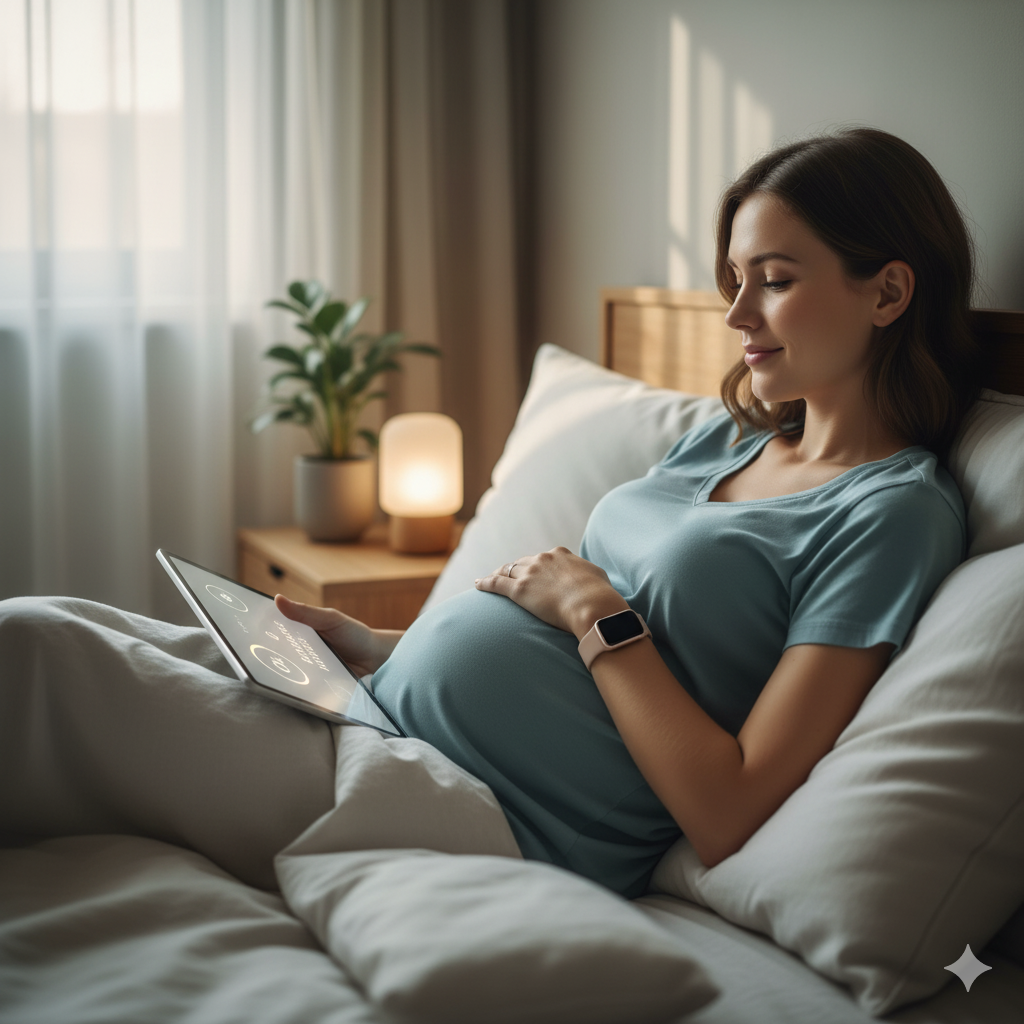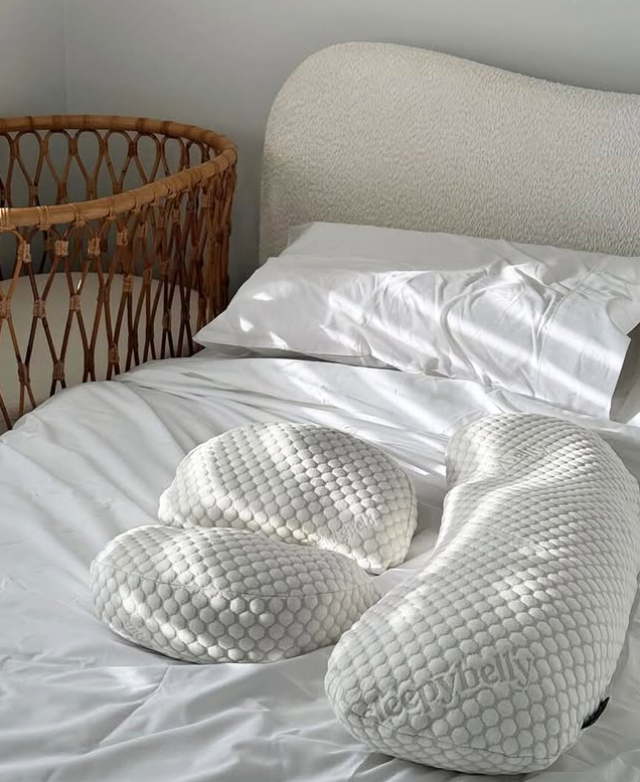You, your bump, your beloved…and a pillow the size of a small cloud. Here’s how to make night-time cosy (and drama-free).
Sharing a bed during pregnancy can be tricky: you’re side sleeping, your hips need support, baby is doing backflips, needing to pee every hour, and your partner is clinging to the edge, wondering where their pillow went. The good news? With a thoughtful setup and the right pregnancy pillow, you can both sleep comfortably—and even cuddle.
Below is a practical, non-judgemental guide to sharing a bed with your pregnancy pillow and partner, using simple tweaks that protect your sleep, your body, and your relationship.

Note: We’ll refer to side-sleeping in pregnancy based on common guidance to avoid back sleeping after the first trimester. For clinical details, see trusted resources within the article.
Why a pregnancy pillow actually helps both of you sleep
-
It supports safe side-sleeping: After the first trimester, experts suggest avoiding sleeping flat on your back. The goal isn’t perfection—just support and comfort that helps you settle on your side more easily.
-
It reduces tossing and turning: Good belly and back support can reduce the constant reshuffling that wakes both you and your partner.
-
It can be compact and couple-friendly: Not all pregnancy pillows are bed hogs. A modular, three-piece design like the Sleepybelly Pregnancy Pillow supports bump and back without taking over the mattress, and it works with your usual head pillow so you keep your familiar setup.
Step-by-step: Set up your bed for two (plus belly)
-
Start with the basics
-
Use your usual head pillows. Comfort is mostly habit—don’t change more than you need to — make sure your pregnancy pillow allows you to do this, as some pillows you have to use it as your head pillow.
-
Check your mattress. If it’s very soft or very firm, a pillow can compensate, but a supportive mattress topper can help distribute pressure across hips and shoulders.
-
Create your side-sleep “lane”
-
Place a wedge under your bump to gently lift and relieve the pull/strain on your belly and hips.
-
Position a long support along your back to prevent rolling onto your back (and give you that “held” feeling that helps the nervous system relax).
-
If you like, add light knee/ankle support to keep hips aligned.
With a three-piece system, this looks like:
-
Side wedge tucked under the belly
-
Long back pillow curved to “hug” your spine
-
Optional second wedge for stability or between the knees

-
Make space for your partner—without sacrificing support
-
Stagger your pillows, not your partner. Angle the back support so it cradles you without bulging into your side.
-
Keep the long support on your side of the bed, parallel to the edge.
-
If one of you is a heat machine, position breathable fabrics near your torso and keep doona layers lighter on the shared side.
4. Night-time feeds and bathroom trips
-
Choose a setup that’s easy to slide in and out of. Modular pillows with connection straps or velcro are quicker to reset at 3 am.
-
Keep pathways clear—no pillows trailing into the foot zone.
Communication tips to keep the peace (and the doona)
-
Set the expectation: “This setup helps me sleep on my side and reduces hip pain. Better sleep for me = fewer wake-ups for both of us.”
-
Invite collaboration: “Which side feels roomier for you?” or “Do you want me to angle the back support a bit more?”
-
Use the “two-pillow rule”: if your partner gets squeezed, you adjust one piece—never the whole setup.
-
Share the cuddle plan: agree on a couple of go-to positions so you’re not negotiating at midnight.
Space-saving tricks for smaller beds
-
Choose compact support, not oversized shapes. O-, C- and I-shaped pillows can be comfy, but many dominate the bed. A modular option is easier to fit in a queen or even a double.
-
Keep your head pillow. Let the pregnancy pillow handle belly/back; your head pillow stays where it belongs.
-
Run the long support parallel to the mattress edge rather than across the middle—this preserves your partner’s “lane”.
-
Swap heavy quilts for layered throws so neither of you feels trapped under bulky bedding.
If you’re worried about space, look for features like:
-
Separate, adjustable pieces
-
Slim wedge that tucks neatly under the bump
-
A long back pillow with a subtle curve rather than a bulky cylinder
Take a look at the compact, bed-friendly design of the Sleepybelly Pregnancy Pillow.
Side-sleeping comfort checklist
-
Belly feels gently lifted, not pushed
-
Back support rests along your natural curve
-
Knees have light support to keep hips neutral
-
You can switch sides without rebuilding the entire fortress
-
Your partner still has room to turn and a clear pillow “lane”
-
You can reach water, lip balm, and your phone without twisting
For partners: how to be a sleep hero
-
Ask what helps. A quick, “Left side or right tonight?” goes a long way.
-
Do the 10-second reset. If a wedge slips, help re-tuck it while she stays comfortable.
-
Offer a switch. If she’s overheating, swap doona sides or adjust the fan.
-
Try the “over-pillow cuddle.” Spoon around the back support; it keeps her aligned and still gives you closeness.
-
Be noise-aware at bedtime and wake-ups—small kindnesses feel huge at 2am.

When to tweak your setup
-
New aches: move the wedge closer to your ribs or lower under the belly; increase knee support to ease hips.
-
Numb hands or shoulder: reduce head-pillow height slightly, and ensure your top arm rests forward on a small cushion.
-
Heat or restlessness: switch to breathable layers; bamboo-blend pillow covers and moisture-wicking pyjamas help regulate temp. Try Sleepybelly’s 3-Piece Maternity Pyjama Set for soft, breathable comfort and an adjustable waistband that’s gentle on C‑section scars.
FAQs
-
Is it really unsafe to sleep on my back?
Guidance commonly suggests side-sleeping is best after the first trimester. Plenty of people wake up on their backs—don’t panic. The aim is to set up your bed so side-sleeping feels easy and comfortable. For more context, see the Royal Women’s Hospital and Sleep Health Foundation below. -
Which side is best?
Left-side is often recommended, but comfort matters. A supportive setup that helps you stay mostly on your side is the win. -
Can a pregnancy pillow make our bed too hot?
Choose breathable covers and lighter bedding. Air-layer bamboo/poly blends and activated latex-style fills can feel cooler than dense foam. If you run hot, place the long support a touch lower along your back to increase airflow. -
Will we ever cuddle again?
Yes—just cuddle “around” the support. Many couples like the over-pillow spoon or hand-hold connect. Remember: better alignment = less pain = more patience for cuddles.
Gentle product picks that play nicely with partners
-
Sleepybelly Pregnancy Pillow: a modular, three-piece design that supports bump and back without monopolising the mattress and converts to a breastfeeding pillow later on.
-
3-Piece Maternity Pyjama Set: breathable bamboo/cotton/elastane with an adjustable waistband. Cooler sleeps = happier bed-sharing.
The takeaway
You don’t have to choose between your pregnancy pillow and your partner. With a compact, adjustable setup and a little teamwork, you’ll create a bed that supports your bump, keeps you off your back without stress, and still leaves room for closeness. Think of the pillow as your quiet third teammate—doing the overnight support work so you both wake up that bit more rested.
When you’re ready to fine-tune your setup, explore the compact, partner-friendly design of the Sleepybelly Pregnancy Pillow—and pair it with breathable Maternity Pyjamas for cooler, calmer nights.



